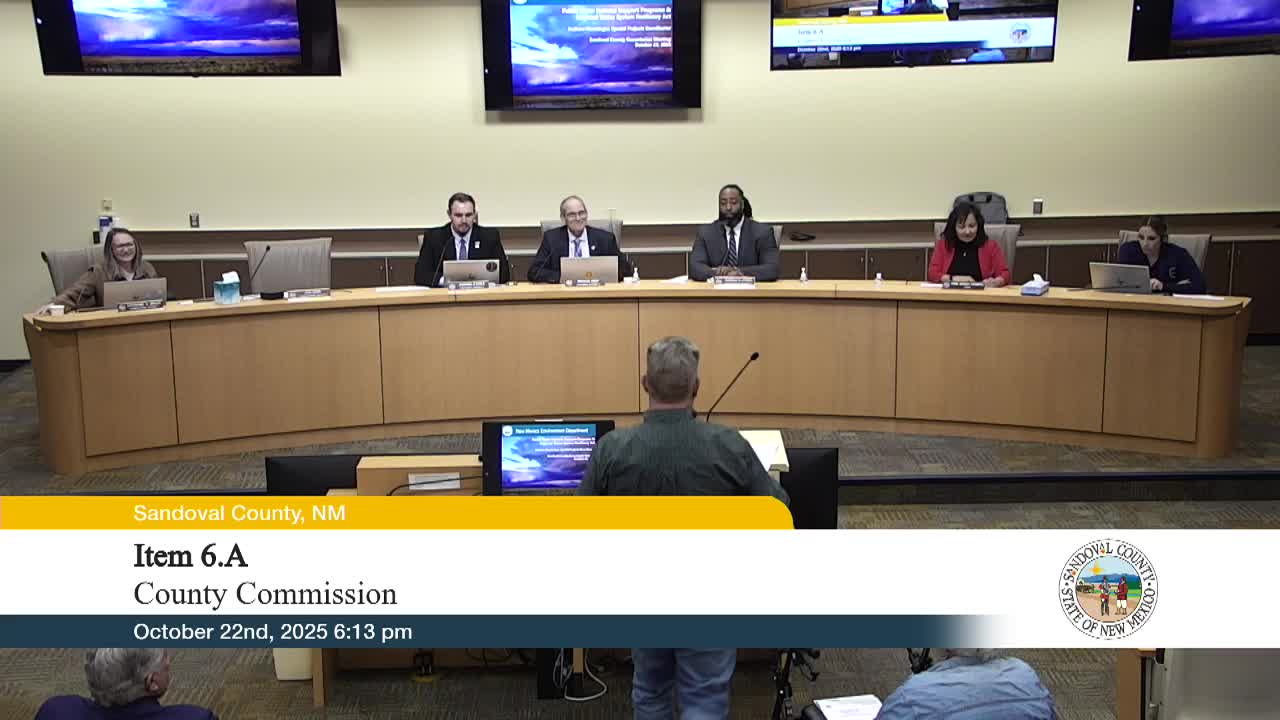State official outlines regionalization push for rural water systems, cites 2023 Regional Water System Resiliency Act
October 22, 2025 | Sandoval County, New Mexico
This article was created by AI summarizing key points discussed. AI makes mistakes, so for full details and context, please refer to the video of the full meeting. Please report any errors so we can fix them. Report an error »

A New Mexico Environment Department (NMED) official told the Sandoval County Board of County Commissioners on Oct. 22 that regionalized water authorities offer a pathway to stabilize small, rural public water systems and help them meet increasingly complex regulatory requirements.
Andrew Houtsinger, special projects coordinator with the NMED's Water Protection Division, described the state’s work to support more than 650 public water systems, most of which serve fewer than 3,000 connections. "Over 90% of the small and rural water systems in New Mexico … have one water source," Houtsinger said, and that lack of redundancy often leaves communities vulnerable when wells fail or infrastructure is damaged.
Why it matters: Houtsinger emphasized that regionalization can create economies of scale and improve the ability to hire professional operators, manage regulatory compliance and increase access to competitive funding. He highlighted the Regional Water System Resiliency Act passed in 2023 (referred to in the presentation as SB 1), which creates a statutory pathway for consolidations and expands eligible participants to include counties, municipalities and water and sanitation districts.
Key points from the presentation
- Technical, managerial and financial capacity (TMF) are central to sustainable water systems; consolidation can help shore up all three legs of the stool.
- SB 1 (2023) creates preapproved mechanisms for consolidating systems, permitting ownership transfer, and allowing consolidated regional authorities to seek public financing including state and federal funds.
- The NMED is working with about 10 systems toward consolidation and cataloged more than 100 regionalization efforts in New Mexico over the previous decades; several have been successful, many have failed for local reasons.
Options discussed for Placitas-area cooperatives
Houtsinger presented consolidation pathways for a group of roughly 15 water co‑ops outside Placitas. Options include converting two or more private co‑ops into public entities that could merge, or seeking legislative changes to broaden eligible participants for state supports. The NMED plans a follow‑up meeting on Nov. 11 to continue discussions with operators and board members in the Placitas area.
Questions and context
Commissioners and participants asked about workforce challenges for water operators; Houtsinger noted a multiyear shortage of certified operators and said state and federal programs could consider incentives or benefit changes to retain operators. Houtsinger also described funding sources such as the Rural Infrastructure Program (RIP) and federal Clean Water and Drinking Water State Revolving Funds.
The NMED emphasized that regionalization is voluntary and can take many forms, from informal mutual aid arrangements to formal ownership transfers under SB 1. Houtsinger said the department will provide a catalog of past regionalization efforts and evaluations of successes and failures to help local decision‑making.
No formal action was required of the board; the presentation was informational and county commissioners said they will host a follow‑up meeting to bring operators and board members together.
Andrew Houtsinger, special projects coordinator with the NMED's Water Protection Division, described the state’s work to support more than 650 public water systems, most of which serve fewer than 3,000 connections. "Over 90% of the small and rural water systems in New Mexico … have one water source," Houtsinger said, and that lack of redundancy often leaves communities vulnerable when wells fail or infrastructure is damaged.
Why it matters: Houtsinger emphasized that regionalization can create economies of scale and improve the ability to hire professional operators, manage regulatory compliance and increase access to competitive funding. He highlighted the Regional Water System Resiliency Act passed in 2023 (referred to in the presentation as SB 1), which creates a statutory pathway for consolidations and expands eligible participants to include counties, municipalities and water and sanitation districts.
Key points from the presentation
- Technical, managerial and financial capacity (TMF) are central to sustainable water systems; consolidation can help shore up all three legs of the stool.
- SB 1 (2023) creates preapproved mechanisms for consolidating systems, permitting ownership transfer, and allowing consolidated regional authorities to seek public financing including state and federal funds.
- The NMED is working with about 10 systems toward consolidation and cataloged more than 100 regionalization efforts in New Mexico over the previous decades; several have been successful, many have failed for local reasons.
Options discussed for Placitas-area cooperatives
Houtsinger presented consolidation pathways for a group of roughly 15 water co‑ops outside Placitas. Options include converting two or more private co‑ops into public entities that could merge, or seeking legislative changes to broaden eligible participants for state supports. The NMED plans a follow‑up meeting on Nov. 11 to continue discussions with operators and board members in the Placitas area.
Questions and context
Commissioners and participants asked about workforce challenges for water operators; Houtsinger noted a multiyear shortage of certified operators and said state and federal programs could consider incentives or benefit changes to retain operators. Houtsinger also described funding sources such as the Rural Infrastructure Program (RIP) and federal Clean Water and Drinking Water State Revolving Funds.
The NMED emphasized that regionalization is voluntary and can take many forms, from informal mutual aid arrangements to formal ownership transfers under SB 1. Houtsinger said the department will provide a catalog of past regionalization efforts and evaluations of successes and failures to help local decision‑making.
No formal action was required of the board; the presentation was informational and county commissioners said they will host a follow‑up meeting to bring operators and board members together.
View full meeting
This article is based on a recent meeting—watch the full video and explore the complete transcript for deeper insights into the discussion.
View full meeting
